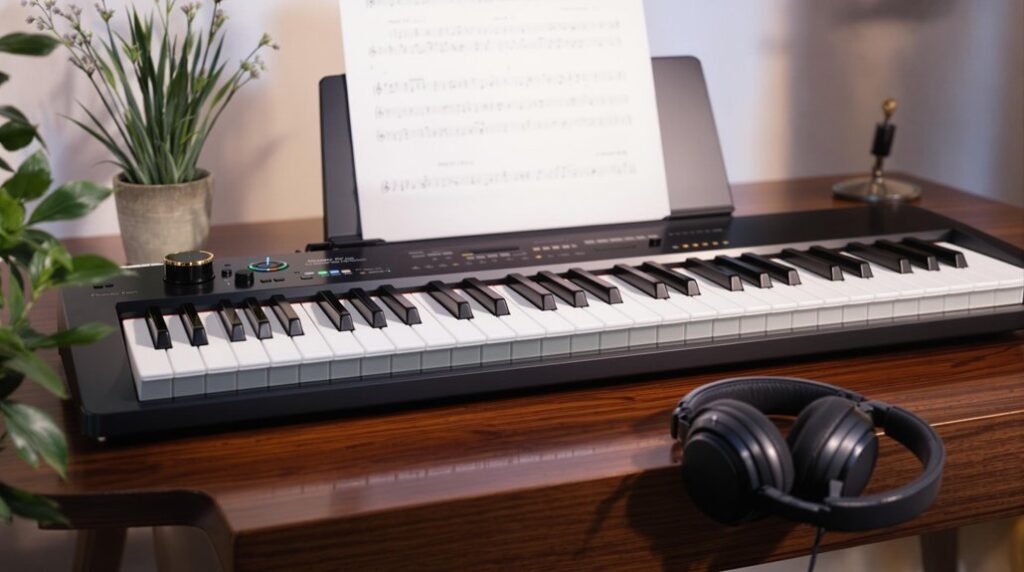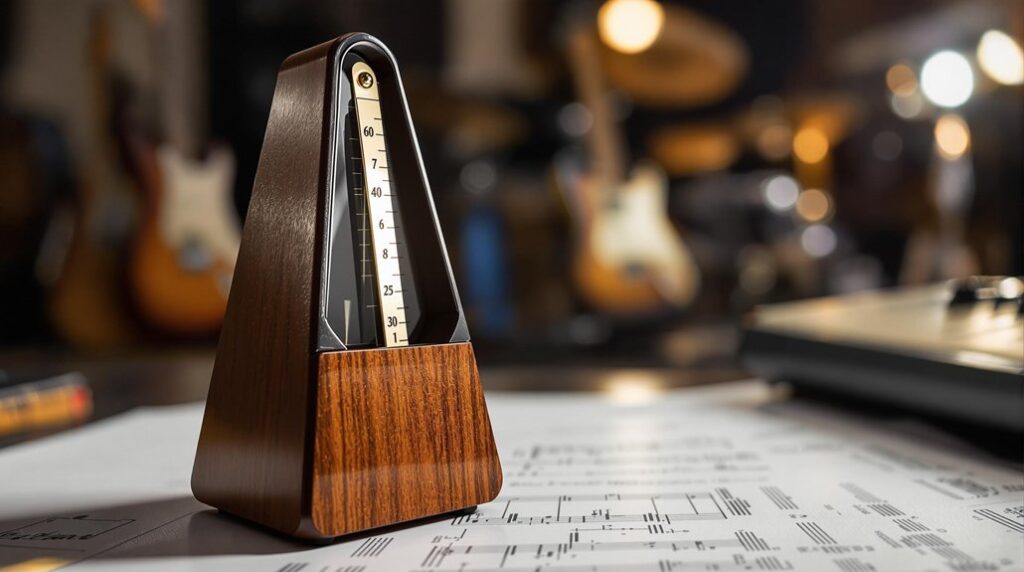Crafting catchy melodic hooks is an art requiring a keen understanding of musical elements. Start with simplicity and repetition; limit your note range and enhance memorability through rhythmic consistency. Experimenting with rhythm variations—such as syncopation or unexpected rests—can inject novelty into your melodies. Aligning hooks with the emotional core of your music guarantees powerful resonance, while strategic placement within the song structure—like in choruses or intros—maximizes impact. By incorporating these techniques, you’ll create enduring hooks that captivate listeners. Explore further to discover how each of these tips can transform your music into an unforgettable experience.
Key Takeaways
- Utilize a limited note range of 2-4 notes to enhance memorability and accessibility in melodies.
- Experiment with unique rhythmic patterns and syncopation to create dynamic and engaging hooks.
- Align melodies with the emotional core of the song to enhance impact and resonance.
- Strategically place hooks in the chorus or post-chorus to maximize impact and memorability.
- Continuously refine hooks based on listener feedback to ensure ongoing improvement and engagement.
Master Simplicity and Repetition
Achieving mastery in simplicity and repetition is a cornerstone for crafting memorable melodic hooks that resonate with audiences. By confining melodic lines to a limited note range of 2-4 notes, songwriters enhance accessibility and memorability for listeners.
Catchy hooks rely on rhythmic consistency and repetition of short, punchy phrases, embedding themselves in the listener’s mind. This approach mirrors the technique used in “When I’m Gone” by 3 Doors Down, where singable qualities captivate audiences.
Simplicity in melody not only aids recall but also boosts replay value considerably. While maintaining the core melody, incorporating subtle variations guarantees continued listener interest. Additionally, understanding the importance of mastering quality ensures that the final mix communicates the intended emotional tone effectively.
Strategically balancing these elements fosters a collaborative environment where technical expertise and creative intuition thrive, producing profoundly effective melodic hooks.
Experiment With Rhythm Variations
Building upon the principles of simplicity and repetition, experimenting with rhythm variations introduces a new layer of complexity and intrigue to melodic hooks. This approach can greatly enhance the catchiness of a hook by developing unique patterns that capture listener interest.
Altering the rhythmic structure of repeated phrases, such as incorporating syncopation and unexpected rests, creates a memorable contrast, ensuring the hook stands out. Consistent syllable counts, as exemplified in 3 Doors Down’s “When I’m Gone,” reinforce memorability while allowing rhythmic variation.
Incorporating varied note lengths and alternating tempos keep melodies dynamic and engaging, preventing monotony. Quirky rhythms, akin to “No Such Thing as a Broken Heart,” invite listeners to replay songs, ensuring lasting impact and enjoyment. Additionally, understanding how syncopation techniques can add depth to your hooks enhances their overall catchiness.
Align Hooks With Emotions
When crafting melodic hooks, aligning them with the emotional core of a song can enhance both impact and memorability. A catchy melody intertwined with emotionally resonant lyrics boosts effectiveness, forging stronger connections with listeners.
Consider these strategies:
- Dynamic Contrasts: Use varied dynamics to emphasize emotional weight and create memorable hooks that capture attention.
- Tempo Adjustment: Tailor the tempo to evoke desired emotions such as excitement or nostalgia, ensuring the catchy musical elements resonate with listeners.
- Audience Feedback: Gather insights on emotional impact from listeners to refine melodies, enhancing their emotional resonance.
Incorporating these strategies can be complemented by understanding dynamic range, which helps maintain clarity and emotional impact in your melodic hooks.
Strategic Placement and Structure
Strategic placement of melodic hooks within a song’s architecture is vital for maximizing their impact and memorability. Positioning hooks in the chorus or post-chorus leverages their repetition, a key element of song structure that enhances listener recall and engagement. Early introduction of hooks, perhaps in the intro, sets a familiar tone, fostering immediate emotional impact. Pre-choruses can build anticipation, heightening excitement when the catchy hook arrives. Repeating hooks at pivotal moments, such as after bridges or verse endings, strengthens their presence and boosts replay value by up to 70%. Smooth shifts into and out of these hooks are essential, ensuring cohesiveness and maintaining listener interest. Additionally, integrating subtle compression can enhance the hook’s clarity, making it stand out more effectively within the overall mix.
| Emotion | Placement | Impact |
|---|---|---|
| Familiarity | Intro | Immediate Engagement |
| Anticipation | Pre-chorus | Heightened Excitement |
| Recall | Chorus | Replay Value |
Frequently Asked Questions
How to Make Catchy Hooks?
Crafting catchy hooks involves balancing melody structure with rhythm patterns, lyrical simplicity, and emotional resonance. Employ repetition techniques, consider instrument choice, and utilize tempo variation and harmonic progression, while tailoring vocal range to genre influence for maximum impact.
How Do You Come up With a Catchy Melody?
To craft a catchy melody, draw on melody inspiration through improvisational techniques and songwriting exercises. Emphasize memorable intervals, rhythmic patterns, and tonal contrast. Enhance emotional resonance with melodic repetition and catchy motifs, considering cultural influences in a collaborative mindset.
How Do You Make a Melodic Hook?
Crafting a melodic hook involves integrating melodic structure with rhythm patterns, enhancing emotional resonance through lyrical synergy and harmonic progression, selecting effective instrumentation choices, employing repetition techniques, utilizing contrast elements, considering cultural influences, and refining songwriting processes collaboratively.
What Makes a Vocal Melody Catchy?
A vocal melody achieves catchiness through catchy rhythms, memorable phrases, and emotional resonance. Repetition techniques, melodic contour, and lyrical integration enhance engagement. Utilizing dynamic range, harmonic support, and unique intervals fosters a compelling connection, enchanting audiences and elevating musical expression.
Conclusion
In crafting catchy melodic hooks, mastery of simplicity and repetition is essential, as these elements foster memorability. Experimentation with rhythm variations can introduce dynamic layers that captivate listeners. Aligning hooks with emotional undertones enhances the listener’s connection, while strategic placement and structure guarantee peak impact and retention. The integration of technical expertise, creative intuition, and a collaborative mindset can yield hooks that resonate profoundly, thereby elevating the overall musical composition to a transformative auditory experience.




